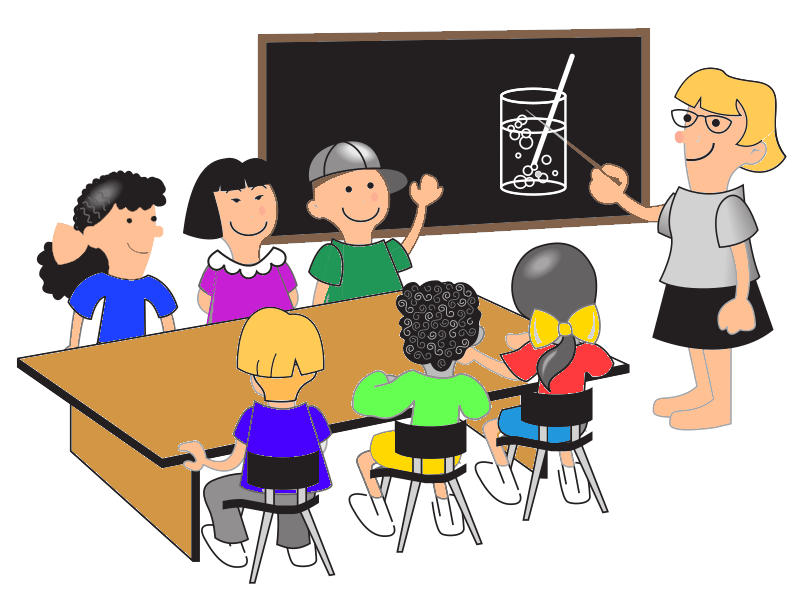Dramatic Play- School Center
Dramatic Play - School Center

Teacher pointing to picture on chalkboard in front of class of 6 students
Description
The dramatic play center provides opportunities for students to collaborate, engage in learning, and build language skills through conversations. Children have the opportunity to role play real-life experiences by taking on many roles in imaginative play. Utilization of the space as a mini "classroom"encourages students to think like teachers, students, and school personnel. It allows children to consider what is required to be a teacher, such as providing student support while teaching new material. It also encourages the child to think about the role of a student at school, and evaluate personal behaviors and actions in the classroom. Children engage in taking turns with peers and developing vocabulary through interactions with one another.
Purpose
- fine motor skills while using magnetic letters to spell words, holding and manipulating writing utensils, using pointers to practice reading and "teaching" others
- math skills will be reviewed when student act out classroom activities
- counting of materials and supplies and 1-1 correspondence when distributing materials to "students"
- writing opportunities to write names of school materials or personnel
- expression of artistic ability by drawing activities performed in the mini classroom
- print exposure to words about school materials, personnel, and classes
- reading opportunities with exposure to variety of books about school behaviors and routines
- expression of feelings and emotions
- creativity, imagination, abstract thinking
- oral communication, vocabulary
- cooperation, sharing, taking turns
Suggested Materials
- magnetic letters and numbers
- sight word cards
- mini pointers
- story retelling cards and flannel board stories
- alphabet and number cards
- stuffed animals for students to "teach" skills
- alphabet and number anchor charts
- counters and other math manipulatives (e.g., shapes)
- child sized easel and table and chairs
- chairs arranged in rows like bus seats with a chair for the bus driver
- white boards and dry erase markers
- writing utensils
- paper, clipboards, notepads
- reading materials - school related books in center, including nonfiction and fiction
Questioning Examples
These guiding questions can be used to assist the teacher, instructional assistant, or parent volunteers in supporting children's development and learning during play.
- What role did you play today and why did you select that role?
- What did you teach to your students today?
- How did you help the students in their learning?
- How did the students act for the teachers and what could have been done differently?
- What materials did you use in this center?
Considerations
This center can be set up with the following areas included: pretend bus area with chairs in rows like a bus with bus driver's chair, area to have the "teacher" stand at an easel, teacher's desk and an area for students to sit on the floor on at seats to observe and follow the "teacher" instructions. Provide an area to store labeled school supplies (in boxes, baskets or containers). A basket/tote with books about education related events should also be in the center for students to explore. In addition, supply writing paper for students to respond to the teachers instructions, teachers provide tasks for students, and a prompt for students to share the role they played and activities completed (see attached prompt). Also, encourage children to try different roles of the teacher, principal, or students .
This center should allow for enough space for at least three students to play with the furniture and props. The dramatic play center should be located in an area of the room that enables students to communicate without disrupting other children's work and play.
Photo Examples
Literature Connections
Many literature connections exist for this topic and can be read to students before introduction of the center or during learning of the theme of education. These books can also be placed in the center for independent exploration by the children. The following are a few suggestions:
"Kindergarten, Here I Come!" by D. J. Steinberg
"David Goes To School" by David Shannon
"Timothy Goes To School" by Rosemary Wells
"Miss Bindergarten Gets Ready for Kindergarten" by Joseph Slate and Ashley Wolff
"Clifford Goes To School" by Norman Bridwell
"Chrysanthemum" by Kevin Henkes
"If You Take a Mouse To School" by Laura Numeroff
"Giraffes Can't Dance" by Giles Andreae
"Froggy Goes To School" by Jonathan London
Downloadable Resources
This is a center sign to be used at the Mini Classroom
This is writing prompt for writing and illustrating about activities in the center
Clipart credit: www.openclipart.org